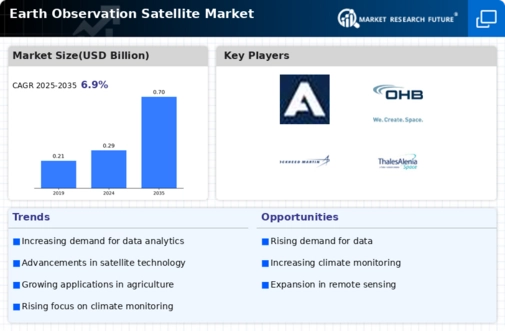Market Trends
Introduction
As we enter 2024, the Earth Observation Satellite Market is experiencing significant transformation driven by a confluence of macro factors. Technological advancements, particularly in miniaturization and data analytics, are enhancing the capabilities of satellite systems, enabling more precise and timely data collection. Concurrently, regulatory pressures aimed at improving environmental monitoring and disaster response are prompting increased investment in satellite infrastructure. Additionally, shifts in consumer behavior, with a growing demand for real-time data across various sectors such as agriculture, urban planning, and climate science, are reshaping market dynamics. These trends are strategically important for stakeholders, as they not only influence competitive positioning but also dictate the direction of innovation and investment in the sector.
Top Trends
-
Increased Demand for High-Resolution Imagery
The demand for high-resolution satellite imagery is surging, driven by applications in agriculture, urban planning, and disaster management. For instance, governments are leveraging high-resolution data for precision farming, which can increase crop yields by up to 20%. This trend is prompting companies to invest in advanced imaging technologies, enhancing operational capabilities and market competitiveness. -
Integration of AI and Machine Learning
Artificial intelligence and machine learning are increasingly being integrated into Earth observation systems to enhance data analysis and interpretation. Companies are utilizing AI algorithms to process vast amounts of satellite data, improving decision-making efficiency. This technological advancement is expected to streamline operations and reduce costs, making satellite data more accessible to various industries. -
Expansion of Small Satellite Constellations
The proliferation of small satellite constellations is reshaping the Earth observation landscape, enabling more frequent and comprehensive data collection. Notable players are launching constellations that can provide near real-time monitoring, which is crucial for applications like climate change tracking. This trend is likely to enhance data availability and foster innovation in satellite services. -
Growing Focus on Climate Monitoring
Governments and organizations are increasingly prioritizing climate monitoring through Earth observation satellites to address environmental challenges. Initiatives like the European Space Agency's Copernicus program are providing critical data for climate research. This focus is driving investments in satellite technology, which will enhance capabilities for tracking climate change and its impacts. -
Enhanced Collaboration Between Public and Private Sectors
There is a notable increase in collaboration between public agencies and private companies in the Earth observation sector. Partnerships are being formed to leverage satellite data for national security and disaster response. This trend is fostering innovation and expanding the market, as shared resources and expertise lead to more effective solutions. -
Advancements in Data Processing Technologies
Innovations in data processing technologies are enabling faster and more efficient analysis of satellite imagery. Companies are adopting cloud computing and edge processing to handle large datasets, significantly reducing processing times. This advancement is expected to enhance operational efficiency and improve the timeliness of data delivery to end-users. -
Rise of Commercial Applications
The commercial sector is increasingly utilizing Earth observation data for various applications, including logistics, insurance, and real estate. Companies are leveraging satellite imagery to optimize supply chains and assess property values. This trend is expanding the market's reach, as more industries recognize the value of satellite data in their operations. -
Regulatory Developments and Compliance
Regulatory frameworks governing satellite operations and data usage are evolving, impacting the Earth observation market. Governments are implementing stricter compliance measures to ensure data security and privacy. This trend is prompting companies to adapt their operations and invest in compliance technologies, which may influence market dynamics and operational costs. -
Increased Investment in Space Infrastructure
Investment in space infrastructure is on the rise, with both governments and private entities funding new satellite launches and ground stations. This trend is essential for enhancing global connectivity and data accessibility. As infrastructure improves, it is expected to facilitate more robust Earth observation capabilities and foster international collaboration. -
Focus on Sustainable Development Goals (SDGs)
Earth observation satellites are increasingly being utilized to monitor progress towards Sustainable Development Goals (SDGs). Organizations are using satellite data to track indicators related to health, education, and environmental sustainability. This trend is driving demand for tailored satellite solutions that support global initiatives, influencing market strategies and product offerings.
Conclusion: Navigating the Earth Observation Landscape
The Earth Observation Satellite Market is characterized by intense competitive dynamics and significant fragmentation, with both legacy and emerging players vying for market share. Regional trends indicate a growing emphasis on sustainability and environmental monitoring, prompting vendors to adapt their strategies accordingly. Legacy players are leveraging established infrastructures and expertise, while emerging companies are focusing on innovative capabilities such as AI, automation, and flexibility to differentiate themselves. As the market evolves, the ability to integrate advanced technologies and prioritize sustainable practices will be crucial for leadership. Decision-makers must consider these strategic implications to effectively position their offerings and capitalize on emerging opportunities.















Leave a Comment